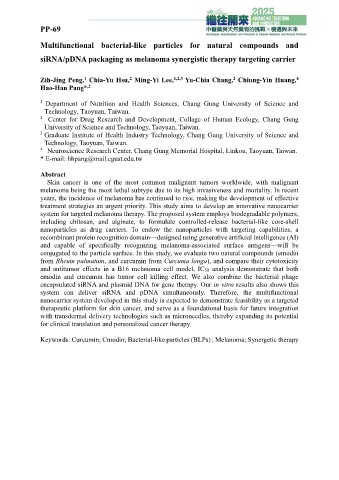Page 252 - 2025中醫藥與天然藥物聯合學術研討會-中醫藥與天然藥物的挑戰X機遇與未來大會手冊
P. 252
PP-69
Multifunctional bacterial-like particles for natural compounds and
siRNA/pDNA packaging as melanoma synergistic therapy targeting carrier
1
2
2
Zih-Jing Peng, Chia-Yu Hsu, Ming-Yi Lee, 1,2,3 Y u -Chia Chang, Chiung‐Yin Huang,
4
Hao-Han Pang*
,2
1 Department of Nutrition and Health Sciences, Chang Gung University of Science and
Technology, Taoyuan, Taiwan.
2 Center for Drug Research and Development, Collage of Human Ecology, Chang Gung
University of Science and Technology, Taoyuan, Taiwan.
3 Graduate Institute of Health Industry Technology, Chang Gung University of Science and
Technology, Taoyuan, Taiwan.
4 Neuroscience Research Center, Chang Gung Memorial Hospital, Linkou, Taoyuan, Taiwan.
* E-mail: hhpang@mail.cgust.edu.tw
Abstract
Skin cancer is one of the most common malignant tumors worldwide, with malignant
melanoma being the most lethal subtype due to its high invasiveness and mortality. In recent
years, the incidence of melanoma has continued to rise, making the development of effective
treatment strategies an urgent priority. This study aims to develop an innovative nanocarrier
system for targeted melanoma therapy. The proposed system employs biodegradable polymers,
including chitosan, and alginate, to formulate controlled-release bacterial-like core-shell
nanoparticles as drug carriers. To endow the nanoparticles with targeting capabilities, a
recombinant protein recognition domain—designed using generative artificial intelligence (AI)
and capable of specifically recognizing melanoma-associated surface antigens—will be
conjugated to the particle surface. In this study, we evaluate two natural compounds (emodin
from Rheum palmatum, and curcumin from Curcuma longa), and compare their cytotoxicity
and antitumor effects in a B16 melanoma cell model, IC50 analysis demonstrate that both
emodin and curcumin has tumor cell killing effect. We also combine the bacterial phage
encapsulated siRNA and plasmid DNA for gene therapy. Our in vitro results also shows this
system can deliver siRNA and pDNA simultaneously. Therefore, the multifunctional
nanocarrier system developed in this study is expected to demonstrate feasibility as a targeted
therapeutic platform for skin cancer, and serve as a foundational basis for future integration
with transdermal delivery technologies such as microneedles, thereby expanding its potential
for clinical translation and personalized cancer therapy.
Keywords: Curcumin; Cmodin; Bacterial-like particles (BLPs) ; Melanoma; Synergetic therapy

